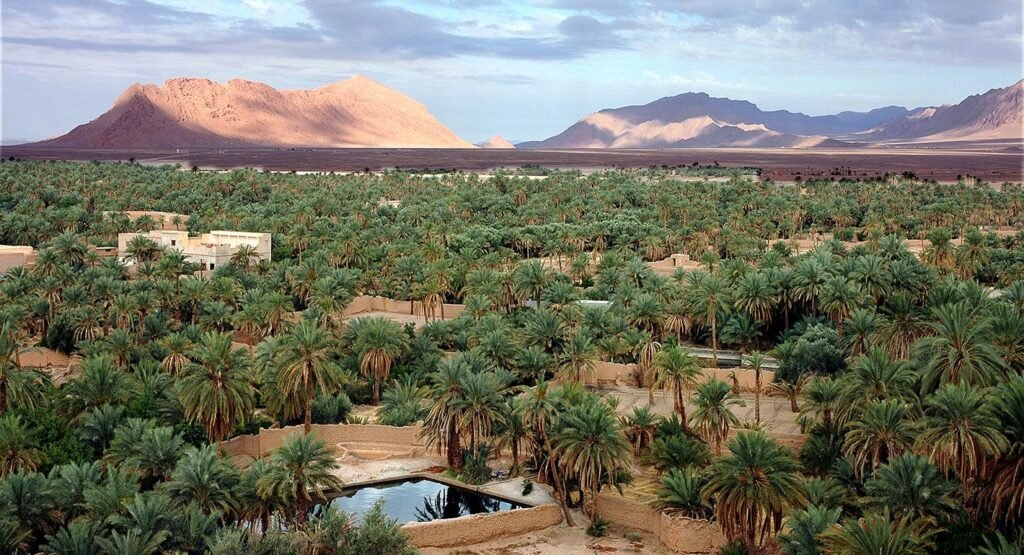
In the heart of Morocco’s Souss-Massa region, a farmer named Hassan wakes before dawn, his calloused hands gripping a worn hoe as he surveys his parched fields. The sun, already fierce, casts long shadows over cracked earth where crops once thrived. For years, Hassan relied on groundwater to irrigate his citrus groves, but the wells are running dry, and the rains are less predictable than ever. His story is not unique—it’s a snapshot of a nation grappling with a water crisis intensified by climate change. Morocco, a land of vibrant souks, ancient medinas, and sprawling deserts, is at a crossroads. Its water policies, shaped by decades of ambition and adaptation, are being tested by rising temperatures, dwindling rainfall, and growing demands. This blog post dives deep into Morocco’s water policy, the challenges posed by climate change, and the innovative solutions emerging to secure a sustainable future. Let’s explore this critical issue through stories, data, and actionable insights, weaving together the human, environmental, and policy threads that define Morocco’s journey.
The Water Crisis: Morocco’s Thirsty Reality
Morocco’s water story begins with its geography. Nestled in northwestern Africa, the country boasts diverse landscapes—from the lush Rif Mountains to the arid Sahara Desert. Yet, this diversity comes with a challenge: water availability varies drastically across regions. The northern areas receive more rainfall, while the south, where Hassan farms, is semi-arid and increasingly parched. According to the World Bank, Morocco is one of the world’s most water-stressed countries, with per capita water availability approaching the critical threshold of 500 cubic meters per year. Climate change exacerbates this, with projections suggesting a 25% decline in water availability by 2030, potentially slashing GDP by 6.5%.
Hassan’s struggle mirrors a national crisis. Over the past 30 years, groundwater levels have plummeted by 20 to 65 meters in key basins like Souss-Massa and Tadla due to over-extraction and reduced recharge. Seawater intrusion and nitrate pollution further degrade water quality, threatening ecosystems and livelihoods. The Al Massira Dam, a vital reservoir, holds just 3% of its average capacity from nine years ago, a stark visual captured by BBC satellite images. As climate models predict a 2–4°C temperature rise and a 53% drop in precipitation by 2100, Morocco’s water scarcity is no longer a distant threat—it’s a present reality.
A Historical Perspective: Morocco’s Water Policy Evolution
Morocco’s approach to water management has deep roots. For centuries, communities used traditional systems like khettaras—underground channels that tap groundwater sustainably—to irrigate fields and sustain oases. These ancestral methods, still used in parts of the Eastern Region, reflect a harmony with nature that modern policies strive to emulate. In 1995, a landmark moment arrived with the introduction of Water Law 10–95, a bold step toward integrated water resource management (IWRM). This law aimed to:
- Rationalize water use through national and river basin plans.
- Ensure universal access to water, bridging urban-rural disparities.
- Promote sustainable agriculture by regulating irrigation.
- Prevent illegal extraction and pollution.
The law was a game-changer, aligning with global sustainability goals and setting the stage for the National Water Strategy (NWS). Yet, as I learned while visiting a cooperative in the Ziz Valley, implementation hasn’t always kept pace with ambition. Farmers there spoke of bureaucratic hurdles and uneven access to resources, highlighting the gap between policy and practice.
Climate Change: The Unrelenting Pressure
Climate change is rewriting Morocco’s water story. In the Rheraya watershed, where snow-capped Atlas Mountains once fed rivers, rising temperatures and a 40–60% reduction in precipitation have shrunk water flows. The Intergovernmental Panel on Climate Change (IPCC) projects that under a business-as-usual scenario (RCP8.5), runoff in Morocco’s highlands could drop by 50–60%, forcing greater reliance on already strained groundwater.
In the Ziz Basin, a pre-Saharan region, prolonged droughts have pushed farmers to drill deeper wells, accelerating groundwater depletion. A 2023 study used the Standardized Precipitation Index (SPI) and Standardized Groundwater Index (SGI) to show that from 1986 to 2016, drought frequency increased, with projections indicating even worse conditions by 2100. Urbanization adds pressure, with the Ziz Valley expecting a population growth of 93,000 by 2029, further straining water resources.
I met Amina, a mother in Errachidia, who described how her village’s once-reliable spring dried up, forcing families to rely on costly water deliveries. “We used to share water like neighbors share bread,” she said, her voice heavy with nostalgia. “Now, we count every drop.” Her story underscores the human toll of climate-driven water scarcity, a crisis that policy must address with urgency and empathy.
The National Water Strategy: A Blueprint for Resilience
Morocco’s response to this crisis is the National Water Strategy (NWS), a comprehensive plan to secure water for a growing population and economy. Launched as part of the 1995 water law’s legacy, the NWS emphasizes:
- Infrastructure Development: Building dams, desalination plants, and water transfer systems like the proposed “Water Highway” to move 860 million cubic meters annually from the wet north to the arid south.
- Demand Management: Encouraging efficient water use through drip irrigation and revised tariffs.
- Sustainability: Protecting aquifers and promoting renewable energy to power water projects.
- Climate Adaptation: Integrating climate projections into planning to mitigate drought and flood risks.
The Souss-Massa basin, where Hassan farms, is a success story. Here, integrated management has balanced quantitative and qualitative needs, using scientific data to monitor groundwater and implement drip irrigation. Yet, challenges persist. The International Monetary Fund (IMF) notes that low water tariffs for agriculture encourage overuse, undermining sustainability. Revising these tariffs could save water and attract private investment, but it risks burdening small-scale farmers like Hassan.
Desalination: A Lifeline or a Double-Edged Sword?
With traditional water sources dwindling, Morocco is betting big on desalination. The country aims to produce over 1 billion cubic meters of desalinated water annually by 2030, supplying cities like Casablanca and Tangier. The Agadir desalination plant, powered partly by wind energy, is a model of innovation, reducing reliance on fossil fuels. A recent post on X highlighted that by 2030, 55% of Morocco’s drinking water could come from desalination, up from 10% today.
However, desalination isn’t a silver bullet. It’s energy-intensive, costly, and can harm marine ecosystems by discharging brine. In coastal areas, increased salinity threatens biodiversity, a concern raised by Rosalux North Africa. I spoke with a local fisherman in Agadir who worried about declining fish stocks near desalination plants. “The sea is our life,” he said. “If it suffers, we suffer.” Morocco’s challenge is to scale up desalination sustainably, balancing economic needs with environmental costs.
Agriculture and Water: A Delicate Balance
Agriculture, employing 40% of Morocco’s workforce, is the backbone of its economy but also its biggest water consumer. The Green Morocco Plan (2008–2020) boosted food production, reducing undernourishment by 25%, but its water-intensive crops like watermelons in arid regions strained resources. The successor, Generation Green 2020–2030, shifts focus to human development and sustainable practices, promoting crops like olives and almonds that require less water.
In the Middle Draa Valley, I saw drip irrigation systems transforming small farms. Farmers there shared how government subsidies helped them switch from flood irrigation, saving water and boosting yields. Yet, as a World Bank report notes, large-scale farmers often benefit more from such programs, leaving smaller ones struggling. Policies must prioritize equity to ensure all farmers, from Hassan to large agribusinesses, can adapt to a drier future.
Comparison Table: Morocco’s Water Management Strategies
| Strategy | Pros | Cons | Examples |
|---|---|---|---|
| Dams and Reservoirs | Regulate water flow, store rainwater, support irrigation and hydropower | High costs, environmental disruption, limited effectiveness in droughts | Al Massira Dam, 140 large dams |
| Desalination | Provides reliable water for coastal cities, reduces groundwater reliance | Energy-intensive, costly, marine ecosystem impacts | Agadir Desalination Plant |
| Drip Irrigation | Saves water, increases crop yields, scalable for small farmers | High initial costs, maintenance challenges, unequal access to subsidies | Souss-Massa, Middle Draa Valley |
| Water Highway Project | Redistributes water from wet to arid regions, supports agriculture | Feasible only under mitigation scenarios (RCP4.5), high infrastructure cost | Proposed transfer of 860M m³/year |
| Traditional Systems | Sustainable, low-cost, community-driven (e.g., khettaras) | Limited scalability, maintenance issues, not suited for urban demands | Eastern Region cooperatives |
Community and Innovation: Grassroots Solutions
Beyond top-down policies, Morocco’s communities are innovating. In the Eastern Region, cooperatives are reviving khettaras to manage water sustainably, blending ancestral knowledge with modern techniques. These efforts, supported by NGOs and local governments, empower rural communities and reduce reliance on overtaxed aquifers. In the Fez-Meknès region, a European Investment Bank project funded a water pipeline that ended chronic shortages, creating jobs and stability.
I visited a women’s cooperative in Tiznit, where members use solar-powered pumps to irrigate almond groves. Their leader, Fatima, beamed with pride as she showed me their thriving trees. “We don’t just grow crops,” she said. “We grow hope.” Such grassroots initiatives, backed by policies like Generation Green, show that Morocco’s future lies in empowering its people.
Policy Gaps and Opportunities
Despite progress, Morocco’s water policies face hurdles. Coordination between scientists and policymakers is weak, limiting the use of climate models in decision-making. The 1995 water law’s IWRM framework is robust but struggles with enforcement, especially in rural areas. Over-reliance on infrastructure like dams and desalination risks neglecting demand management and conservation.
Opportunities abound, though. Morocco’s push for renewable energy, aiming for 52% of electricity from renewables by 2030, could power sustainable water projects. Public awareness campaigns and equitable subsidy programs could encourage conservation, while international partnerships, like those with the U.S. Agency for International Development, can fund innovative technologies.
FAQ: Common Questions About Morocco’s Water Policy and Climate Change
Q: How severe is Morocco’s water crisis?
A: Morocco is among the world’s most water-stressed nations, with per capita water availability nearing 500 m³/year, worsened by climate change-induced droughts and over-extraction.
Q: What is the National Water Strategy?
A: The NWS is Morocco’s plan to manage water through infrastructure (dams, desalination), demand management (drip irrigation, tariffs), and climate adaptation, aiming for sustainability and equity.
Q: How does climate change affect Morocco’s water resources?
A: Rising temperatures (2–4°C by 2100) and reduced precipitation (up to 53%) shrink surface and groundwater, increase drought frequency, and threaten agriculture and ecosystems.
Q: What role does desalination play?
A: Desalination is a key strategy, targeting 1 billion m³/year by 2030, but it’s costly, energy-intensive, and can harm marine life, requiring sustainable energy solutions.
Q: How can individuals help?
A: Support conservation by reducing water waste, advocating for sustainable policies, and supporting cooperatives using efficient irrigation or traditional systems like khettaras.
Conclusion: A Path Forward for Morocco
Morocco’s water story is one of resilience, innovation, and adaptation. From Hassan’s parched fields to Fatima’s thriving cooperative, the nation’s people are at the heart of its response to climate change. The National Water Strategy, built on the 1995 water law, has laid a strong foundation, but the road ahead demands bold action. Climate projections paint a challenging picture—less rain, hotter days, and strained resources—but Morocco’s blend of modern infrastructure, traditional wisdom, and community-driven solutions offers hope.
To secure a sustainable future, Morocco must bridge policy gaps, strengthen coordination between science and governance, and prioritize equitable access to resources. Investments in renewable energy and demand management can reduce the environmental toll of desalination and irrigation. International support, from institutions like the World Bank and USAID, can amplify these efforts, while grassroots initiatives empower communities to lead change.
As readers, we can learn from Morocco’s journey. Advocate for sustainable water policies in your own region, support local conservation efforts, and stay informed about climate impacts. Morocco’s story reminds us that water is life, and preserving it requires collective will. Let’s draw inspiration from Hassan, Amina, and Fatima, and work toward a world where every drop counts.
